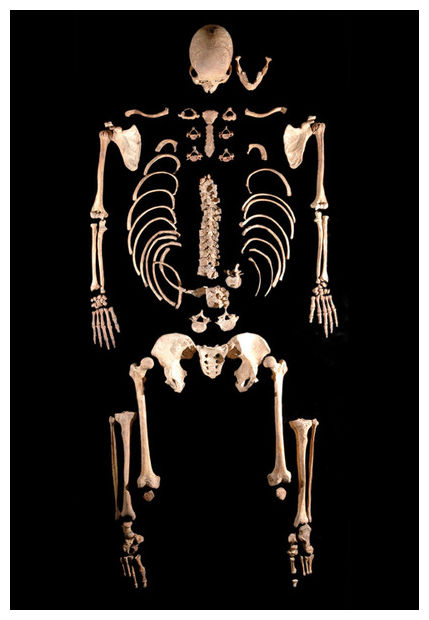
The first modern human hunter-gatherers occupied Europe at least 40,000 years ago. But their fortunes waxed and waned with fluctuations in climate, and during the height of the last ice age - between about 25,000 and 20,000 years ago - they were forced to take refuge in southern European regions such as modern-day Spain, Portugal, and southern France. Only after 12,000 years ago, when a permanent warming trend set in, were they able to spread across all of Europe again, marking the beginning of a period called the Mesolithic.
Yet, while researchers have intensively studied the ancient farmers who followed them, relatively little is known about Europe's Mesolithic people. Scientists have extracted ancient DNA from dozens of farmer skeletons, but from fewer than 30 Mesolithic skeletons. Nearly all of these are from central and Eastern Europe.
In the new study, published online today in Current Biology, a team led by geneticist Carles Lalueza-Fox of the University of Barcelona in Spain sequenced DNA from both mitochondria, the cell's tiny energy plants, and the cell nucleus from two complete, remarkably well-preserved skeletons found in 2006 in a cave complex called La Braña-Arintero in northwest Spain. The remains, both males (as determined from the size of their pelvises and their DNA), were a few meters apart and found in a crouching position. Radiocarbon dates pegged both skeletons at about 8000 years old*; the dates were so close in fact, within the margin of error of the technique, that the humans may have been deposited in the cave at the same time. And one of the skeletons, called La Braña 2, was adorned with 24 pierced canine teeth from red deer, which had apparently been embroidered on a cloth that once covered the body.
The team was able to extract mitochondrial DNA (mtDNA) from both sets of remains, and to completely sequence the mtDNA from the La Braña 1 skeleton. Lalueza-Fox and his colleagues also succeeded in sequencing nuclear DNA from the two skeletons, amounting to 1.34% and 0.53% of the La Braña 1 and 2 genomes, respectively. They got two primary results: First, the nuclear and mtDNA sequences bore little relationship to those of modern-day Europeans from Iberia (Spain and Portugal). Second, both skeletons were members of a mtDNA genetic group called U5b, which is rare among Europeans today (about 7%) but is represented by nearly half of the Mesolithic skeletons across Europe that have produced ancient DNA -- 12 out a total of 27 Mesolithic skeletons now analyzed, according to the team's survey of the scientific literature.
The first finding, Lalueza-Fox and other researchers say, is consistent with a number of other recent studies, which have found that modern Europeans descend largely from the migrant farmers who spread across Europe and not from the hunter-gatherers who preceded them. But the finding that the Spanish skeletons share the U5b genetic profile with Mesolithic individuals from as far away as Poland, Lithuania, Germany, and the United Kingdom, is "amazing," Lalueza-Fox says. Although the first farmers spread quickly across Europe, trading and exchanging culture across thousands of kilometers, many researchers had assumed that Mesolithic nomadic hunter-gatherers lived in small, isolated bands with little contact over long distances. But the genetic picture, Lalueza-Fox says, suggests "highly mobile" groups that kept in touch and interbred continent-wide.
This genetic profile is supported by archaeological evidence for widespread contacts, the team argues. Thus the use of red deer teeth as personal ornaments was widespread across Europe during the Mesolithic, covering much of the same territory as the U5b genetic groups found so far. This suggests, the researchers contend in their paper, that "the La Braña individuals had tight cultural affinities with those distant regions."
Lounès Chikhi, a geneticist at Paul Sabatier University in Toulouse, France, says he was "very surprised" that the La Braña skeletons had such close genetic affinities with central and eastern European hunter-gatherers, because he would have expected many more genetic differences between them. Nevertheless, he cautions that too few Mesolithic skeletons have been analyzed to draw firm conclusions.
Martin Richards, a geneticist at the University of Huddersfield in the United Kingdom, says that the data look "persuasive and exciting," but should be considered only preliminary because the "sample sets are tiny at the moment" and small sample sizes can produce "misleading" results. He adds that since about only half of the Mesolithic skeletons analyzed are in the U5b group, Mesolithic peoples were still "pretty diverse" and not as uniform as the team contends. "Unfortunately, some ancient DNA researchers seem unable to resist making sweeping claims about the ancient genetic structure of whole regions."
Solange Rigaud is even more skeptical. An archaeologist at the University of Bordeaux in France who has studied red deer canine ornaments from La Braña and other sites in Europe, she says the team is wrong to see the widespread use of ornamental teeth as evidence for close cultural contacts across the continent. Mesolithic peoples used widely varying techniques to produce the perforations in the canines, Rigaud says, suggesting that although they started with the same raw materials, deer teeth, they had different cultural traditions when it came to the way they actually crafted the ornaments.
*Radiocarbon dates have been calibrated to reflect fluctuations in atmospheric radiocarbon between prehistoric times and the present day.



Reader Comments
to our Newsletter